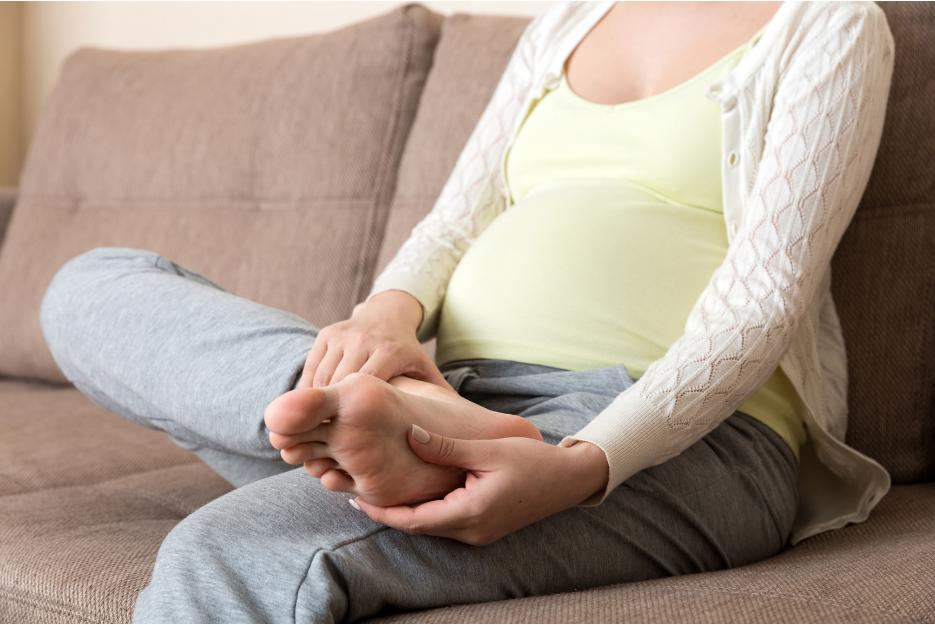Pregnancy & Your Feet
Background
Pregnancy brings exciting changes, including those to a woman’s feet, which can lead to common but often overlooked foot complaints. As weight increases and the abdomen grows, a woman’s centre of gravity shifts forward, altering the forces on the bones and joints of the knees, ankles, and feet. Additionally, hormones released during pregnancy relax the ligaments in the feet, further contributing to changes.
Common issues include flattening of the feet and arches (pronation) and swelling (oedema), which can cause pain in the heel, arch, and ball of the foot. Pregnant women may also experience leg cramps, varicose veins, and sciatica pain shooting down the legs. These symptoms can significantly impact walking and overall comfort, making it important for expecting mums to address foot problems promptly and adopt effective care strategies.

Table of Contents
Flat Feet (Pronation)
Excessive pronation also increases strain on other areas, including the calves, shins, and back muscles. The additional weight gain during pregnancy can further exacerbate these symptoms, causing discomfort and worsening pain as the pregnancy progresses through the trimesters.
Swelling (Oedema)
Visit Us Today
Hope Island
Phone: 07 5510 9222
Located within Hope Island Marketplace Medical & Skin Clinic, 99-103 Broadwater Ave Hope Island QLD 4212
Jimboomba
Phone: 07 5546 9766
Located Within Jimboomba Medical Centre, Unit 1/69 Cerina Cct, Jimboomba QLD 4280
Beenleigh
Phone: 07 3287 2224
Located Within Beenleigh Mall Medical Centre, Shop24A, 40/68 Main Street, Beenleigh QLD 4207
Eagleby
Phone: 07 2889 1666
Located Within Eagleby Family Practice, 5/120 River Hills Rd, Eagleby QLD 4207
Harristown
Phone: 07 4635 6111
Located Within Toowoomba Medical Centre, 146 Drayton Road, Harristown QLD 4350
Marsden
Phone: 07 3067 2370
Located Within Marsden Family Doctors, Shop 28/55-77 Chambers Flat Rd, Marsden QLD 4132
Keperra
Phone: 07 3355 4082
Located Within Keperra Medical Clinic, 14 Dallas Parade Keperra QLD 4054
Coomera
Phone: 07 5573 5663
Located Within Doctors @ Coomera Central, Shop 6, 21 Coomera Grand Drive, Upper Coomera, QLD 4209
Newtown
Phone: 07 4633 8700
Located Within Ochre Medical Centre Wyalla, Shop 20, 238 Taylor Street, Newtown QLD 4350
Treatment And Prevention
The good news is that both excessive pronation and swelling during pregnancy can be managed to help you walk more comfortably.
For managing pronation, wearing supportive shoes with built-in arch support is key. Many women also benefit from custom foot orthotics, which provide additional relief by offering the right arch support and heel posting to correct excess pronation. Opt for footwear that provides extra support and shock absorption.
Treating pronation not only offers pain relief and comfort but also helps prevent other foot problems such as plantar fasciitis, heel spurs, metatarsalgia, tibialis posterior tendonitis, and bunions.
To minimize swelling in the feet, try the following:
- Elevate your feet regularly, especially if sitting for long periods, by using a small stool.
- Wear well-fitting shoes, avoiding narrow or short footwear that constricts circulation.
- Have your feet measured throughout pregnancy, as they may change size.
- Choose seamless socks to avoid constricting circulation.
- Take breaks during long drives to stretch and promote circulation.
- Exercise regularly; walking is particularly beneficial.
- Stay hydrated by drinking plenty of water to help reduce fluid retention.
- Eat a well-balanced diet and avoid excessive salt intake.
Swelling should typically be similar in both feet; if it is asymmetrical, it could indicate a vascular issue and should be checked by a doctor immediately.
Enquire Now
Not The Condition You Are Looking For?
Find out more about the conditions we treat by clicking below.
